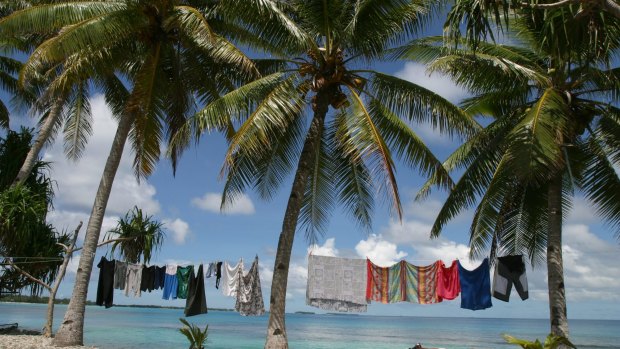This was published 5 years ago
Australia's $4b aid program refocused to deal with COVID-19 recovery
Australia has shelved a major review of its $4 billion foreign aid program and will instead redirect hundreds of millions of dollars over the next two years to help countries in the Indo-Pacific tackle the coronavirus pandemic.
The COVID-19 development plan, to be revealed on Friday, will take money from programs that require international travel and face-to-face engagement – including scholarships, sports and volunteer schemes – and instead spend it on pandemic recovery initiatives.

A portion of Australia's foreign aid budget will be refocused, with the Pacific, Timor-Leste and Indonesia named as key priorities.Credit: Richard Vogel
The review of the development budget, being led by former ambassador and intelligence boss Dennis Richardson, will be revisited in about two years, with the government deciding the COVID-19 outbreak had changed how Australia should direct its aid in the interim.
The roughly $4 billion Australia spends on aid – or 0.2 per cent of gross national income – won't change under the COVID-19 plan, but a portion will be refocused, with the Pacific, Timor-Leste and Indonesia named as key priorities.
More than $280 million has been reallocated this financial year to help countries in the region deal with the pandemic, with more to come in 2020-21. The funds will help them respond to outbreaks, prepare for the possibility of further waves of infections, maintain social and political stability and kickstart their economies.
Australia has been pursuing its Pacific "step up", committing billions of dollars to much-needed infrastructure in the region amid concerns China is building its influence on Australia's doorstep. Beijing has also stepped up its presence during the pandemic, sending medical supplies to countries in the Pacific.
Foreign Minister Marise Payne and International Development and the Pacific Minister Alex Hawke said Australia's neighbours were particularly vulnerable to the health and economic impacts of the pandemic.
"The growth, openness and stability of the Indo-Pacific, which has underpinned Australia’s prosperity and security for decades, is at risk," Senator Payne and Mr Hawke said in the forward to the plan.
"The elderly, poor and other vulnerable groups are disproportionately affected. How our neighbourhood emerges from this crisis will determine Australia's economic and strategic circumstances for decades to come. We must move quickly to tackle these problems together with our partners. It will not be easy."
While the global pandemic has so far affected developed nations the hardest, it is believed the lasting impacts could hit developing nations more.
The World Bank estimates remittance flows – the largest source of money in low and middle-income countries – will this year drop by about 20 per cent, or $100 billion. Up to 60 million people will be pushed into extreme poverty, which would be the first increase in global poverty rates since 1998.
The Australian government is concerned the pandemic will throw millions out of work, make economic and gender inequality worse, encourage criminal activity and spur irregular migration.
Australia has already deployed health experts throughout the region, sent personal protective equipment and medical supplies to 23 countries and territories, established an isolation centre in Timor-Leste and provided financial support to Pacific Island nations.
With commercial flights brought to a standstill, Australia is working with New Zealand to maintain an "Australia-Pacific Corridor" so humanitarian flights can continue to the region. The humanitarian corridor – a complex logistical system of flights, consular, health and quarantine support – has ensured the continued supply of essential medical and testing equipment, critical personnel and food supplies.
It is also talking with Pacific nations about them joining the proposed trans-Tasman bubble with New Zealand.
The new plan also talks about the critical importance of a vaccine for COVID-19 and the importance of all countries being able to access a vaccine when, or if, it becomes available.